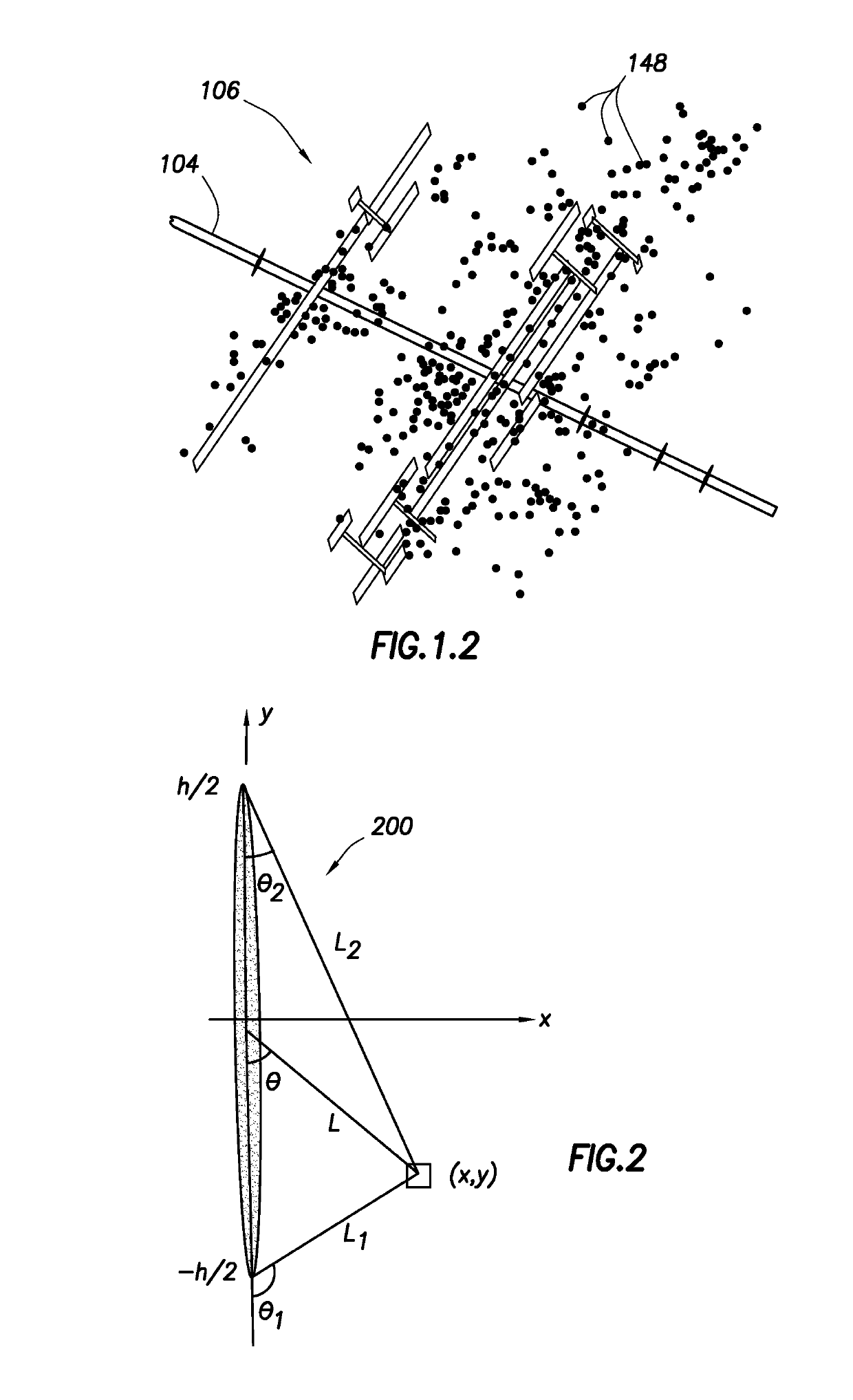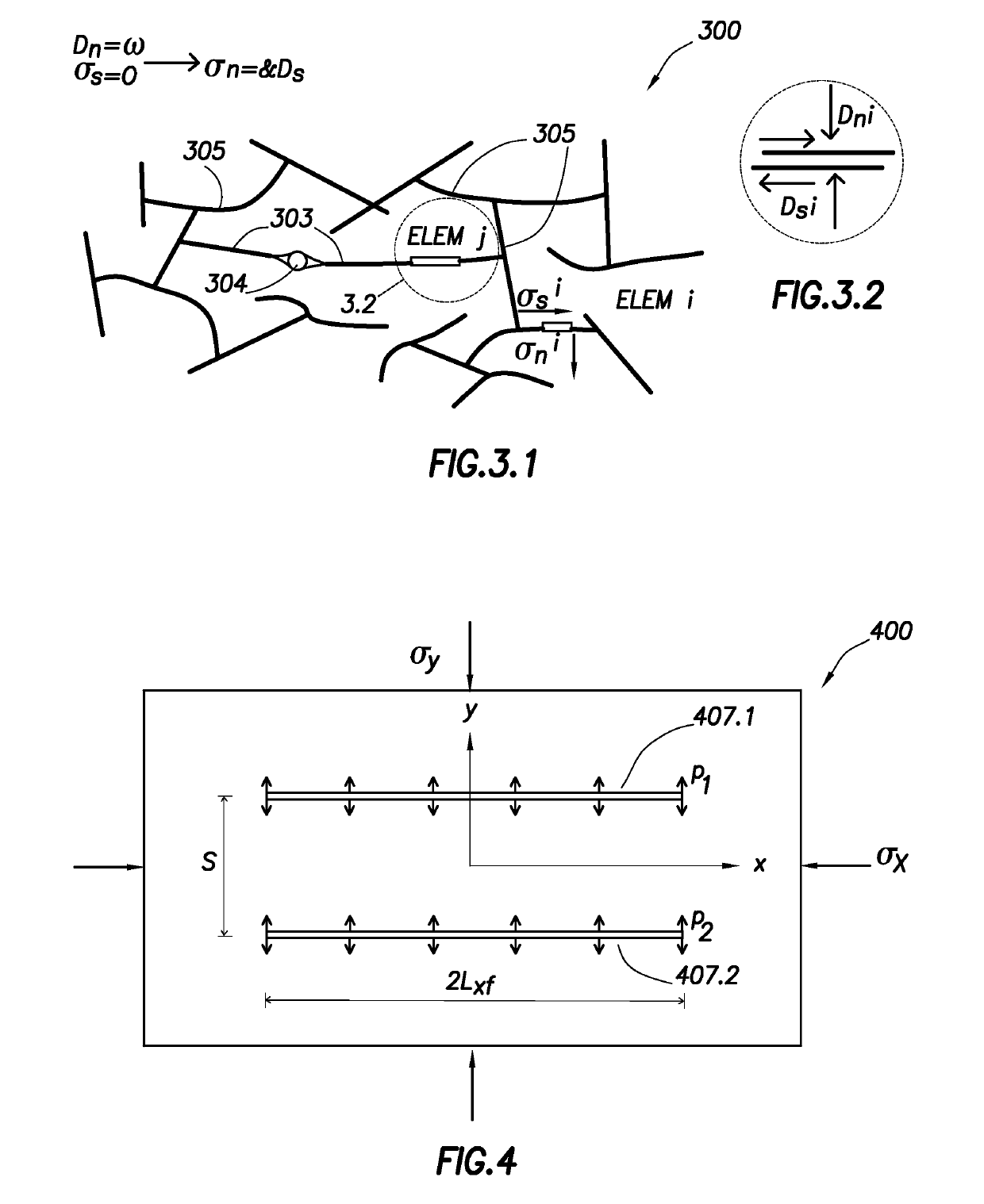Method of calibrating fracture geometry to microseismic events
a microseismic event and fracture geometry technology, applied in the field of fracture operations, can solve the problems of deviating from the drilling plan, affecting the degree of complexity of the resulting fracture network, and difficulty in distinguishing between small scale fracture complexity and simple planar fracture growth
- Summary
- Abstract
- Description
- Claims
- Application Information
AI Technical Summary
Benefits of technology
Problems solved by technology
Method used
Image
Examples
example cases
Case #1—Parallel Fractures in Horizontal Wells
[0127]FIG. 8 is a schematic plot 800 of parallel transverse fractures 811.1, 811.2, 811.3 propagating simultaneously from multiple perforation clusters 815.1, 815.2, 815.3, respectively, about a horizontal wellbore 804. Each of the fractures 811.1, 811.2, 811.3 provides a different flow rate q1, q2, q3 that is part of the total flow qt at a pressure p0.
[0128]When the formation condition and the perforations are the same for all the fractures, the fractures may have about the same dimensions if the friction pressure in the wellbore between the perforation clusters is proportionally small. This may be assumed where the fractures are separated far enough and the stress shadow effects are negligible. When the spacing between the fractures is within the region of stress shadow influence, the fractures may be affected not only in width, but also in other fracture dimension. To illustrate this, a simple example of five parallel fractures may be...
case # 2
Case #2—Complex Fractures
[0137]In an example of FIG. 12, the UFM model may be used to simulate a 4-stage hydraulic fracture treatment in a horizontal well in a shale formation. See, e.g., Cipolla, C., Weng, X., Mack, M., Ganguly, U., Kresse, O., Gu, H., Cohen, C. and Wu, R., Integrating Microseismic Mapping and Complex Fracture Modeling to Characterize Fracture Complexity. Paper SPE 140185 presented at the SPE Hydraulic Fracturing Conference and Exhibition, Woodlands, Tex., USA, Jan. 24-26, 2011, (hereinafter “Cipolla 2011”) the entire contents of which are hereby incorporated by reference in their entirety. The well may be cased and cemented, and each stage pumped through three or four perforation clusters. Each of the four stages may include of approximately 25,000 bbls (4000 m3) of fluid and 440,000 lbs (2e+6 kg) of proppant. Extensive data may be available on the well, including advanced sonic logs that provide an estimate of minimum and maximum horizontal stress. Microseismic m...
case # 3
Case #3—Multi-Stage Example
[0141]Case #3 is an example showing how stress shadow from previous stages can influence the propagation pattern of hydraulic fracture networks for next treatment stages, resulting in changing of total picture of generated hydraulic fracture network for the four stage treatment case.
[0142]This case includes four hydraulic fracture treatment stages. The well is cased and cemented. Stages 1 and 2 are pumped through three perforated clusters, and Stages 3 and 4 are pumped through four perforated clusters. The rock fabric is isotropic. The input parameters are listed in Table 4 below. The top view of total hydraulic fracture network without and with accounting for stress shadow from previous stages is shown in FIGS. 13.1-13.4.
[0143]
TABLE 4Input parameters for Case #3Young's modulus4.5 × 106 psi = 3.1e+10 PaPoisson's ratio0.35Rate30.9 bpm = 0.082 m3 / sViscosity0.5 cp = 0.0005 pa-sHeight330 ft = 101 mPumping time70 min
[0144]FIGS. 14.1-14.4 are schematic diagrams ...
PUM
 Login to View More
Login to View More Abstract
Description
Claims
Application Information
 Login to View More
Login to View More - R&D
- Intellectual Property
- Life Sciences
- Materials
- Tech Scout
- Unparalleled Data Quality
- Higher Quality Content
- 60% Fewer Hallucinations
Browse by: Latest US Patents, China's latest patents, Technical Efficacy Thesaurus, Application Domain, Technology Topic, Popular Technical Reports.
© 2025 PatSnap. All rights reserved.Legal|Privacy policy|Modern Slavery Act Transparency Statement|Sitemap|About US| Contact US: help@patsnap.com



